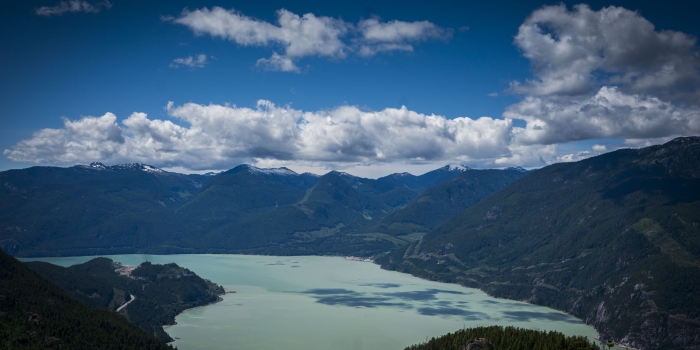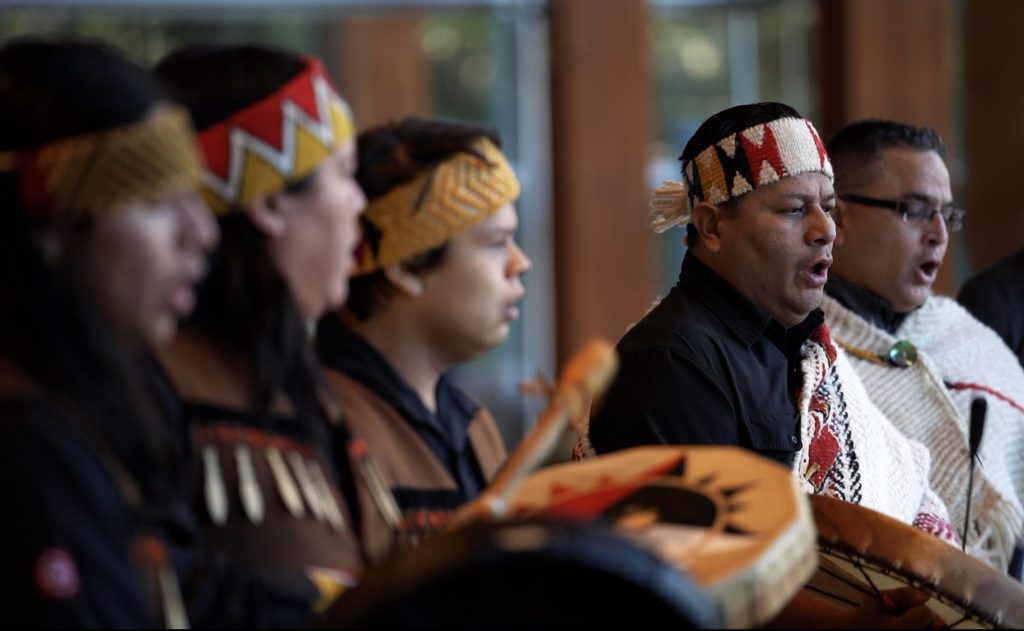RGE Journalism Workshop 2014
24 senior journalists and editors from Indonesia attended a three-day RGE Journalism Workshop in Singapore December 2-4 2014. This year’s workshop is in partnership with the Nanyang Technological University (NTU),...

Latest updates on what's happening in RGE Group

This article is an adaptation of “The world’s lowest emission LNG”, published in LNG Industry North America. Changes include rewriting some of the passages and adding original materials.
Woodfibre LNG is a privately-held Canadian company that is constructing an LNG export facility about 7 km southwest of Squamish, British Columbia, Canada. The Woodfibre LNG Project is unique – for a few reasons.
The project’s history
Since 1912, Swiy̓át (the site’s traditional Squamish Nation name) has provided industrial opportunities for generations of local families in the community – Woodfibre LNG is keeping up this tradition. For over 100 years, the site (only accessible by boat), was home to one of British Columbia’s oldest pulp mills. In 2015 the company took ownership of the industrially-zoned site and began planning for the 2.1 million tpy LNG export facility. The site is already equipped with an existing natural gas pipeline, an existing electrical transmission line, and a deepwater port. Access to existing hydroelectricity on site will allow the project to reduce emission by over 80% and produce the lowest-emission LNG in the world. Powering the facility by renewable hydroelectricity from BC Hydro will result in 14 times fewer stationary combustion emissions than the liquefaction of a conventional LNG facility powered by natural gas.
Honouring tradition
The Woodfibre LNG Project has its regulatory approvals from the federal and provincial governments and is the first industrial project in Canada to recognise a non-Treaty Indigenous government, Skwxwu7mesh Uxwumixw (Squamish Nation), as a full project regulator. This is important because the project is situated within the traditional territories of the Squamish Nation. The Squamish Nation conducted an independent environmental assessment of the project and, in 2015, granted Woodfibre LNG an environmental certificate, which is the first legally binding, Indigenous-led approval of a project in Canada. The project, which holds a 40-year export license, is subject to 25 unique Squamish Nation environmental assessment conditions that must be met throughout the life of the project. These will be monitored in collaboration with Squamish Nation. Woodfibre LNG recognises the importance of local and Indigenous economic participation in the project and works with project partners to maximise employment, training, contracting, and other business opportunities for local and Indigenous people.
Design changes
As a result of consultation with the Squamish Nation, Woodfibre LNG made important design changes to the project. Examples include:
Another early, fundamental design decision made in response to Squamish Nation concerns over potential air quality impacts was to power the facility with electricity from BC Hydro instead of natural gas. Woodfibre LNG is one of the first LNG facilities in Canada to commit to being powered by electric drive compressors using renewable hydroelectricity.
Prioritising emissions
Woodfibre LNG has prioritised emissions avoidance and reduction opportunities from the outset. Maintaining respectful and meaningful partnerships with local Indigenous groups underpins the project’s approach to developing its net zero roadmap and to building and running the project in a way that contributes to a resilient community in Squamish and a net zero future for Canada, and the world. In March 2023 Woodfibre LNG announced its Roadmap to Net Zero, making the export facility the first in the world to achieve net zero emissions, 23 years ahead of government regulation. The roadmap includes commitments to be net zero both through the construction stage of the project and during operations. The project’s net zero roadmap follows the British Columbia government’s announcement of a new Energy Action Framework, requiring proposed LNG facilities currently in or entering the environmental assessment process to develop and submit a credible plan to be net zero by 2030.
Woodfibre LNG was already designed to be the lowest carbon intensive LNG export facility in the world, with an annual emission profile of 83,374 t of carbon dioxide equivalent (CO2-e)/y, and a carbon intensity of 0.04 (t of CO2-e/t of LNG) well below the Provincial benchmark of 0.16.
As part of its net zero roadmap, Woodfibre LNG will also offset emissions during the construction phase of the project. Woodfibre LNG’s robust strategy has been independently validated by a Canadian climate engineering firm, Brightspot Climate Inc., and is consistent with Canada’s Methane Strategy and draft guidance for best-in-class greenhouse gas emission performance by oil and gas projects.
The facility will use hydroelectricity to power the main liquefaction process, including technology to enable compressors to restart without flaring, cameras, and leaks detection and repair surveys to detect and remedy fugitive leaks. When considering emissions, Woodfibre LNG recognises the importance of the full lifecycle of emissions.
The natural gas fuelling the project
Responsibly-produced natural gas is a necessary part of making a successful global transition from heavy-emitting fuels to renewables. By harnessing the low-carbon gas resources of British Columbia’s Montney region to replace coal-fired energy sources in Asia through signed offtake agreements with BP, Woodfibre LNG will reduce global emissions by 3.5 million tCO2-e/y, equivalent to removing 5% of British Columbia’s annual emissions from the atmosphere every year.
The natural gas required by the project will come from Woodfibre LNG’s upstream affiliate company, Pacific Canbriam Energy, in Northeastern, British Columbia. Pacific Canbriam Energy will deliver feed gas via an existing pipeline that will be extended (gas from the region is transported to the Vancouver area by Enbridge’s T-South pipeline) to the Woodfibre LNG facilities from its reserves in the Montney Altares and Kobes Montney regions. In 2021, Pacific Canbriam Energy became the second gas producer in the North America to achieve EO100TM Standard certification for the production of Certified Responsibly Sourced Gas (C-RSG). This certification confirms Pacific Canbriam’s leadership in the use of innovative and transparent practices and processes to produce some of the world’s most responsible natural gas. Both Woodfibre LNG and Pacific Canbriam Energy are located in British Columbia, which attests to both companies’ adherence to some of the world’s most stringent environmental regulations and policies to ensure sustainable and responsible production of both natural gas and LNG.
Transforming the site
Woodfibre LNG is an industrial transformation project that is helping to improve the environmental condition of a historic pulp mill site that operated for over 100 years.
The project has been conducting remediation work since 2018, which has included the removal of approximately 400 creosote piles, hundreds of old tyres, and tonnes of rebar and concrete. To date, Woodfibre LNG has invested over CAN$12million in site cleanup. Remediation work has created local employment opportunities with contracts awarded to seven British Columbia-based companies. Site preparation activities are currently underway to prepare for the start of construction in September 2023. This includes more concrete recycling, demolition of old buildings, landfill capping, green zone activities, soil remediation, shoreline rehabilitation (including continued creosote pile removal) and habitat offsetting.
Woodfibre LNG continues to take progressive steps towards being prepared for climate change and natural disasters as outlined in its net zero roadmap. This includes developing management plans for fire abatement, wildfire threats, floods and debris flows, sea-level rise, coastal hazards, and undertaking baseline studies on hydrological and meteorological elements.
In 2021, Woodfibre LNG signed an EPFC contract with McDermott International. The EPFC contract was followed by a Notice to Proceed (NTP) in 2022 that signalled an important step in advancing detailed engineering and construction scheduling work. Enbridge took a 30% non-operating stake in the Woodfibre LNG Project in 2022.

Woodfibre LNG believes the project can be an integral part of reconciliation with Indigenous people of Canada and prioritises the hiring of qualified Squamish Nation members and local workers
It is estimated that up to 800 people will work on the Woodfibre LNG site at peak construction. McDermott will manage onshore construction, leveraging regional-based contractors and commitments included in Woodfibre LNG’s Impact Benefit Agreements with the Squamish Nation. The EPFC contract commits McDermott to Woodfibre LNG’s hiring priority for qualified Squamish Nation members and local workers first, followed by British Columbians and then other Canadians. The joint priority is to create a safe, inclusive and respectful workplace that brings benefits to the project’s Indigenous partners and local community.
Looking to the future
Within the next four years, the Woodfibre LNG Project will start production, and will be the lowest-emission LNG facility in the world. The facility will create 100 new operations jobs which will remain for the lifetime of the project, maintaining the legacy of this unique site in British Columbia that has been rich with industry for decades and with Indigenous history for millennia.
The world needs Canadian LNG. Woodfibre LNG is demonstrating that it is possible to produce certified responsibly sourced, low emission energy in a way that aligns with environmental goals and indigenous reconciliation priorities.